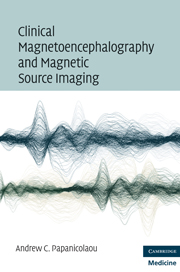Book contents
- Frontmatter
- Contents
- Contributors
- Preface
- Section 1 The method
- 1 Basic concepts
- 2 The nature and origin of magnetic signals
- 3 Recording the magnetic flux
- 4 Overview of MSI using the single equivalent current dipole (ECD) model as an example
- 5 The fundamental problems of MSI
- 6 Head models
- 7 Source models – discrete source models
- 8 Source models – distributed source models
- 9 Source models – beamformers
- 10 Pragmatic features of the clinical use of MEG/MSI
- Section 2 Spontaneous brain activity
- Section 3 Evoked magnetic fields
- Postscript: Future applications of clinical MEG
- References
- Index
5 - The fundamental problems of MSI
from Section 1 - The method
Published online by Cambridge University Press: 01 March 2010
- Frontmatter
- Contents
- Contributors
- Preface
- Section 1 The method
- 1 Basic concepts
- 2 The nature and origin of magnetic signals
- 3 Recording the magnetic flux
- 4 Overview of MSI using the single equivalent current dipole (ECD) model as an example
- 5 The fundamental problems of MSI
- 6 Head models
- 7 Source models – discrete source models
- 8 Source models – distributed source models
- 9 Source models – beamformers
- 10 Pragmatic features of the clinical use of MEG/MSI
- Section 2 Spontaneous brain activity
- Section 3 Evoked magnetic fields
- Postscript: Future applications of clinical MEG
- References
- Index
Summary
The allure and promise of MEG lies in its ability, noninvasively and on a millisecond time scale, to measure events that allow us to make inferences regarding the locations, orientations, time courses, and strengths of the source regions that produced the measured signals. This process has been named variously “source estimation,” “source analysis,” “source localization,” “source imaging,” or “bioelectromagnetic inversion.” Each term reflects one aspect of MEG. Source estimation is an umbrella term that emphasizes both the statistical inference and the inherent uncertainty involved in deriving intracranial sources that give rise to the magnetic activity recorded on the head surface. Source localization refers specifically to the problem of determining the spatial location of these brain sources or “generators.” Source analysis emphasizes the conceptual analyses or the model building involved in using a relatively small number of discrete (typically dipolar) sources. Source imaging emphasizes the kinship of MSI to other imaging modalities, such as MRI, but tends to blur some of the uncertainty inherent in the estimation problem. Finally, the term bioelectromagnetic inversion emphasizes the reliance of the process on electromagnetic theory.
Regardless of the name used to identify the MSI process, an inherent uncertainty always exists in the estimates obtained. In fact, that there can be no unambiguous characterization of the intracranial generators has been known since the middle of the nineteenth century. This uncertainty is intrinsic to the nature of the process and cannot be removed by inventing clever algorithms or by conducting extremely accurate measurements. The causes of the uncertainty are embedded in the physics of the magnetic field and may be summarized as follows.
- Type
- Chapter
- Information
- Publisher: Cambridge University PressPrint publication year: 2009



